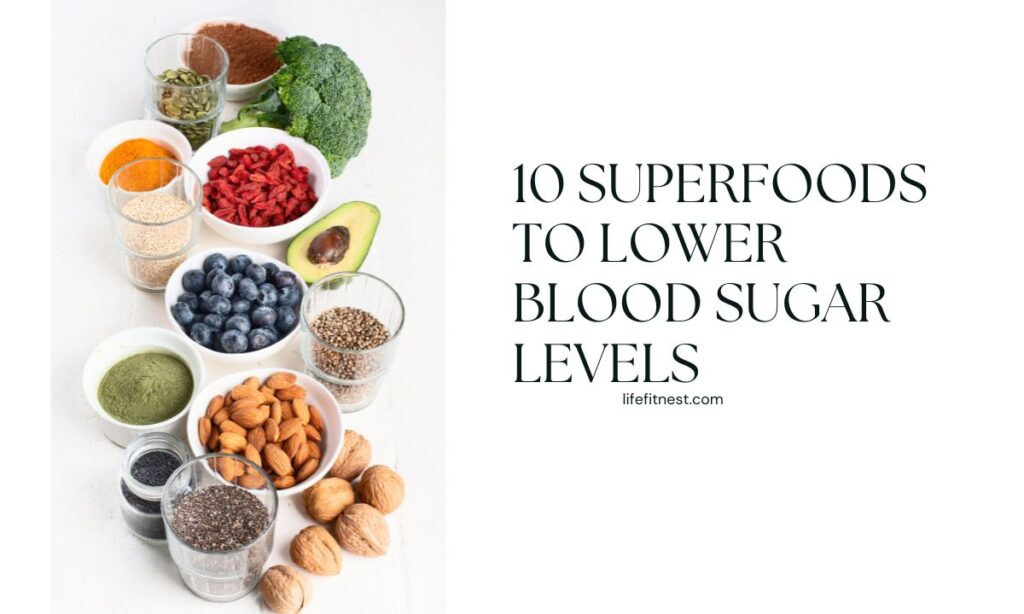A lack of insulin production or an inability to use insulin can cause a spike in blood sugar levels, eventually leading to diabetes. Constant spikes in blood sugar levels can damage blood vessels and nerve cells. Not only that, but it can harm other body organs, resulting in vision loss, kidney damage, and an increased risk of disease and stroke.
This situation can only be controlled by lowering blood sugar levels through a healthy diet, exercise, and taking medications at regular intervals. Diabetes mellitus is managed primarily through diet. A diabetic’s diet should include everyday foods in adequate amounts to maintain an ideal body weight and control blood sugar levels. To maintain a healthy blood sugar level, include the following foods in your diet:
Chia Seeds
Chia seeds contain high levels of antioxidants, omega-3 fatty acids, fiber, and magnesium. All of these nutrients are important for lowering the risk of type 2 diabetes and its complications. One ounce of chia seeds contains 10 grams of fiber. Adults should consume between 24 and 33 g of fiber per day, depending on their age and gender.
Pumpkin Seeds
Pumpkin seeds are high in magnesium, fiber, and healthy fats. Our bodies require magnesium to break down food into energy. It is very common in diabetic patients to have low magnesium levels due to insulin resistance, which is one of the causes of diabetes. Consuming magnesium-rich foods has been shown to lower the risk of developing type 2 diabetes. Adults should consume pumpkin seeds to maintain stable blood sugar levels.
Walnuts
Walnuts are an excellent source of fiber, protein, and healthy fat. It was also discovered that people who ate nuts more frequently appeared to have a lower risk of gaining weight than those who did not. When a diabetic patient loses weight, their blood glucose levels improve. Nuts’ soluble and insoluble fibers can help to improve blood sugar levels, lower cholesterol, and reduce the risk of diabetes-related complications.
Whole Grain Bread
Whole grains contain more protein and nutrients and are high in minerals, vitamins, and antioxidants. Studies have shown that eating whole grain bread, particularly sprouted grain bread, improves blood sugar levels in obese people.
Cinnamon
Cinnamon consumption has been shown in studies to help lower their blood sugar levels. According to a recent study conducted by a leading diabetic institute, people with diabetes who took cinnamon supplements had higher levels of body mass index (BMI), blood sugar levels, and lipid levels than those who did not. Cinnamon can be consumed by adding it to sweet potatoes or roasted carrots, stirring it into tea or warm milk, or sprinkling it over oatmeal instead of sugar.
Tomatoes
Foods with a low (GI) are thought to be best for diabetic patients because they gradually release sugar into the bloodstream. These foods do not cause a spike in blood sugar during this process. Fresh, whole tomatoes are one of the foods with a low glycemic index (GI) and a high fiber content, which help people feel fuller for longer periods of time. Studies have shown that consuming 1-2 medium-sized tomatoes per day reduced in diabetic patients after 8 weeks. So it is safe to say that eating tomatoes may help reduce the risk of cardiovascular diseases associated with type 2 diabetes.
Strawberries
Strawberries are rich in vitamin C and antioxidants. According to doctors, eating strawberries reduces diabetes-related brain and kidney complications. Strawberries are a delicious fruit that can be included in your meal, in addition to their nutritional value. However, diabetic patients should be aware that a cup of strawberries contains 7 g of sugar, so they should avoid adding sugar to them.
Avocado
Avocado is a superfood rich in healthy fats, vitamins, fiber, and minerals. Avocados contain high levels of potassium, vitamins C, E, and K, as well as lutein and beta-carotene. According to research, eating foods rich in healthy fats increases fullness levels. Consuming these healthy fats reduces carbohydrate digestion, allowing for a more stable blood sugar level. Half an avocado contains approximately 6 – 7 grams of fiber, which can help reduce the complications and risks associated with diabetes.
Ginger
An anti-inflammatory food is one that is plant-based and contains a high level of antioxidants. These foods reduce inflammation, which means they can help with the symptoms and long-term risks of diseases like diabetes. Ginger, like other antioxidant-rich foods, has anti-inflammatory properties. According to recent research, ginger reduces fasting blood sugar levels in people with type 2 diabetes, improving insulin sensitivity. The best way to consume ginger is to peel it fresh in boiling water and make ginger tea, or to add fresh ginger to a homemade salad as a dressing.
Green, leafy vegetables.
According to recent studies, a low potassium intake has been linked to an increased risk of diabetes and its complications. Leafy vegetables such as spinach, methi, and cabbage are thought to be good sources of dietary potassium. A cup of spinach contains 167mg of potassium and a variety of vitamins and minerals. Green leafy vegetables can be consumed in smoothies, as a sandwich dressing, stir-fried with olive oil on an omelet, or cooked into pasta sauce.
Must Read: 14 Creative Ways to Break Your Child’s Smartphone Addiction
Finally, a diabetic must follow a proper diet, exercise regularly, and take medication. A diabetic should stick to regular meal times, dividing meals into six portions rather than three, and should avoid eating large meals at once. They should eat foods high in fiber, lean protein, slow-digesting carbohydrates, and healthy fats to help them control their blood sugar.
Always choose vegetables, grains, beans, and berries over white bread and pasta. Always avoid foods with a high GI index; instead, opt for low-GI foods such as oatmeal, muesli, and non-starchy vegetables. A diabetic should never miss a meal or medication, avoid alcohol on an empty stomach, and maintain a healthy body weight.


![Understanding Leukemia: A Comprehensive Overview [2024]](https://newstechblog.com/wp-content/uploads/2024/08/cancerHealth-1-1024x536.png)
![Coughing up Phlegm: Causes, Symptoms, and Treatment [2024]](https://newstechblog.com/wp-content/uploads/2024/08/Coughing-up-Phlegm-Causes-Symptoms-and-Treatment-1024x614.jpg)